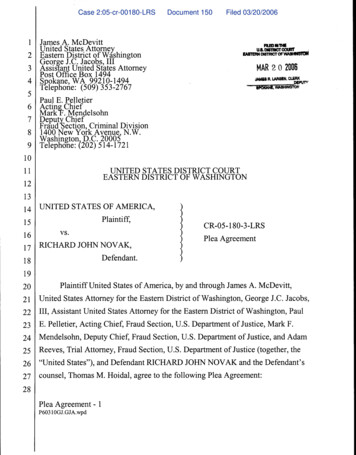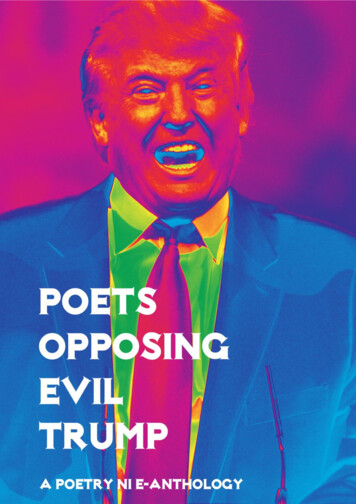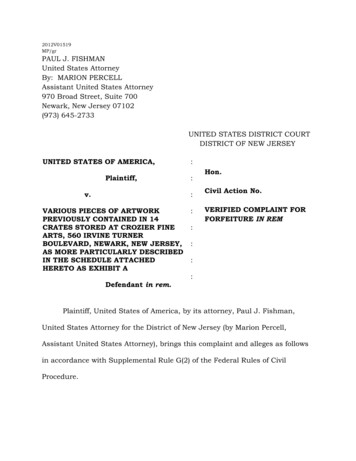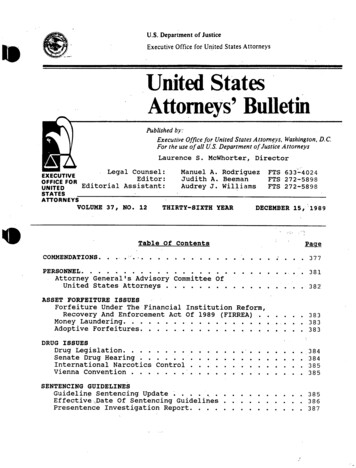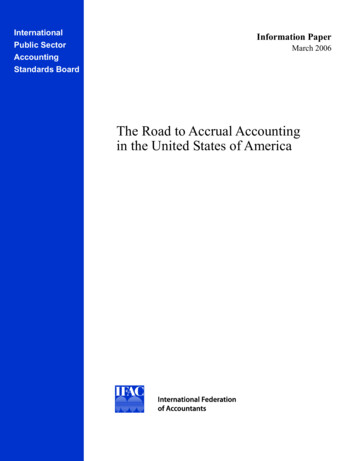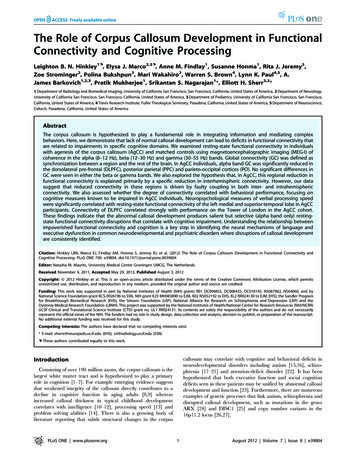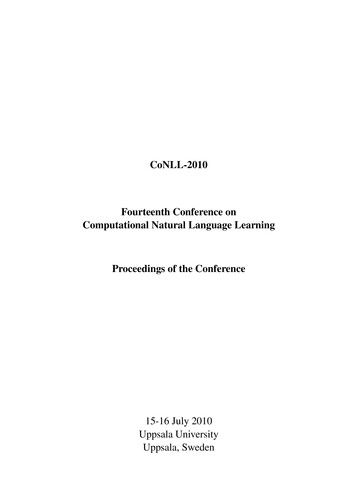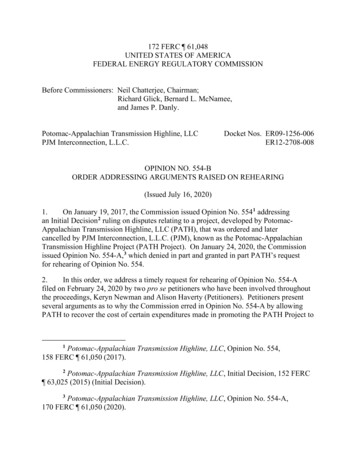
Transcription
172 FERC ¶ 61,048UNITED STATES OF AMERICAFEDERAL ENERGY REGULATORY COMMISSIONBefore Commissioners: Neil Chatterjee, Chairman;Richard Glick, Bernard L. McNamee,and James P. Danly.Potomac-Appalachian Transmission Highline, LLCPJM Interconnection, L.L.C.Docket Nos. ER09-1256-006ER12-2708-008OPINION NO. 554-BORDER ADDRESSING ARGUMENTS RAISED ON REHEARING(Issued July 16, 2020)1.On January 19, 2017, the Commission issued Opinion No. 554 1 addressingan Initial Decision 2 ruling on disputes relating to a project, developed by PotomacAppalachian Transmission Highline, LLC (PATH), that was ordered and latercancelled by PJM Interconnection, L.L.C. (PJM), known as the Potomac-AppalachianTransmission Highline Project (PATH Project). On January 24, 2020, the Commissionissued Opinion No. 554-A, 3 which denied in part and granted in part PATH’s requestfor rehearing of Opinion No. 554.2.In this order, we address a timely request for rehearing of Opinion No. 554-Afiled on February 24, 2020 by two pro se petitioners who have been involved throughoutthe proceedings, Keryn Newman and Alison Haverty (Petitioners). Petitioners presentseveral arguments as to why the Commission erred in Opinion No. 554-A by allowingPATH to recover the cost of certain expenditures made in promoting the PATH Project to1Potomac-Appalachian Transmission Highline, LLC, Opinion No. 554,158 FERC ¶ 61,050 (2017).2Potomac-Appalachian Transmission Highline, LLC, Initial Decision, 152 FERC¶ 63,025 (2015) (Initial Decision).3Potomac-Appalachian Transmission Highline, LLC, Opinion No. 554-A,170 FERC ¶ 61,050 (2020).
Docket Nos. ER09-1256-006 and ER12-2708-008-2-local governments and stakeholders. Pursuant to Allegheny Defense Project v. FERC,4the rehearing requests filed in this proceeding may be deemed denied by operation oflaw. As permitted by section 313(a) of the Federal Power Act (FPA), 5 however, we aremodifying the discussion in Opinion No. 554-A and continue to reach the same result inthis proceeding, as discussed below. 6I.Background3.The full history of the PATH Project is detailed in Opinion No. 554. The PATHProject was to be a 275-mile, 765 kV line from Amos Substation in West Virginiathrough Virginia to a new Kemptown Substation in Maryland. Before abandonment,PATH filed applications for certificates of public convenience and necessity (CPCN) inMaryland, Virginia, and West Virginia. 7 To support these CPCN applications, PATHcontracted with various companies to conduct advocacy activities to influence publicofficials, trade groups, and other stakeholders in support of PATH’s licensing process.As explained below, PATH also spent funds to “[p]roactively communicate projectbenefits , [s]olicit third party endorsements , [m]itigate opposition by communityofficials,” 8 and assist with “Government Relations.” 9 PATH collects funds from PJMmembers under two transmission formula rates (Formula Rates) that were developed andlater revised through settlement negotiations. 10 The Formula Rates are organized by the4Allegheny Defense Project v. FERC, No. 17-1098 (D.C. Cir. June 30, 2020).516 U.S.C. § 825l(a) (2018) (“Until the record in a proceeding shall have beenfiled in a court of appeals, as provided in subsection (b), the Commission may at anytime, upon reasonable notice and in such manner as it shall deem proper, modify or setaside, in whole or in part, any finding or order made or issued by it under the provisionsof this chapter.”).6Allegheny Defense Project, slip op. at 30. The Commission is not changing theoutcome of Opinion No. 554-A. See Smith Lake Improvement & Stakeholders Ass’n v.FERC, 809 F.3d 55, 56-57 (D.C. Cir. 2015).7See, e.g., Opinion No. 554, 158 FERC ¶ 61,050 at PP 2-3, 102; PATH RehearingRequest at 10-13.8Ex. S-2 at 19.9Id. at 20-21.10See Potomac-Appalachian Transmission Highline, LLC, 122 FERC ¶ 61,188, atP 3 (2008), on reh’g, 133 FERC ¶ 61,152 (2010) (granting rehearing, setting the baseROE of 12.3% for hearing and settlement judge procedures, and approving the 2009settlement agreement filed by PATH and several parties resolving Formula Rate issues,
Docket Nos. ER09-1256-006 and ER12-2708-008-3-Commission’s Uniform System of Accounts (USofA). If a given expenditure fits intoone of the USofA accounts that is listed in the Formula Rates, then it is eligible forrecovery; if the expenditure instead fits into one of the USofA accounts that is not listedin the Formula Rates, then it is not eligible for recovery. Using the Formula RateProtocols, 11 Petitioners had challenged PATH’s proposal to recover these advocacy andadvertising expenditures.4.Opinion No. 554 found that PATH’s Formula Rates did not permit recoveryof the disputed expenditures for the purpose of influencing public opinion, because theyare properly recorded in Account 426.4 (Expenditures for Certain Civic, Political andRelated Activities). 12 Opinion No. 554 then found that PATH improperly shifted suchexpenditures to accounts that were in PATH’s Formula Rates, namely, Account 101(Electric Plant in Service), Account 105 (Electric Plant Held for Future Use), Account107 (Construction Work in Progress), Account 923 (Outside Services Employed),Account 930.1 (General Advertising Expenses), and Account 930.2 (MiscellaneousGeneral Expenses). 13 Further, Opinion No. 554 ruled that a separate clause in theFormula Rates limits PATH’s recovery of Account 930.1 (General Advertising) coststo only those that are “Safety Related Advertising, Education and Out Reach [sic] CostSupport.” 145.In a February 21, 2017 request for rehearing from Opinion No. 554, PATHargued that the Commission erred in re-classifying these expenditures into eitherAccount 426.4, or into the unrecoverable subset of Account 930.1. In OpinionNo. 554-A, the Commission reversed, and ruled that the disputed advocacy expendituresin Account 426.4 should be placed into Account 923, and are thus recoverable, 15 andas set forth in Attachments H-19, H-19-A, and H-19-B of the PJM Open AccessTransmission Tariff).11PJM Open Access Transmission Tariff, Attachment H-19 – PotomacAppalachian Transmission Highline, LLC, 2.0.0 (Protocols).12See Opinion No. 554, 158 FERC ¶ 61,050 at PP 48-49, 54-55.13See, e.g., id. PP 62, 75, 81-83.14Id. P 63 (citing PJM Open Access Transmission Tariff, Attachment H-19A atPATH-WV Attachment 4 and PATH-AYE Attachment 4).15Opinion No. 554-A, 170 FERC ¶ 61,050 at PP 79-88.
Docket Nos. ER09-1256-006 and ER12-2708-008-4-that the disputed advertising costs in the unrecoverable subset of Account 930.1 shouldbe shifted to the recoverable subset of Account 930.1. 16II.Filing and Responsive Pleadings6.Petitioners seek rehearing of the Commission’s reversal on Account 426.4 andAccount 930.1 expenditures. As detailed below, Petitioners raise numerous distinctarguments, which we organize into process arguments, accounting arguments, andpolicy arguments, and consider in turn below in the discussion sections.7.On March 10, 2020, PATH submitted a limited answer, addressing what itconsiders to be factual inaccuracies in Petitioners’ request for rehearing. PATH arguesthat in the past, the Commission has held that Rule 213 of the Commission's Rules ofPractice and Procedure 17 allows the Commission to accept answers to rehearing requeststhat assist the Commission’s understanding and resolution of the issues raised or thatensure a complete record. 18 Rule 713(d) of the Commission’s Rules of Practice andProcedure 19 prohibits an answer to a request for rehearing. Accordingly, we denyPATH’s motion to answer and reject PATH’s answer to Petitioners’ rehearing request.III.Process ArgumentsA.Rehearing Request8.Petitioners state that under Rule 713 of the Commission’s Rules of Practice andProcedure, the Commission must act on a request for rehearing within 30 days after therequest is filed, otherwise the request is denied by operation of law. 20 Petitioners assertthat the Commission failed to timely act on PATH’s request for rehearing of OpinionNo. 554-A, and thus the request actually was automatically denied by operation of law. 219.Petitioners further explain that on February 3, 2017, the Commission issued anOrder Delegating Further Authority To Staff In Absence of Quorum (Delegation Order),16Id. PP 98-101.1718 C.F.R. § 385.213 (2019).18PATH March 10, 2020 Answer at 2.1918 C.F.R. § 385.713(d) (1) (2019).20Petitioners Request for Rehearing at 11 (citing 18 C.F.R. § 385.713(f);16 U.S.C. § 825l(a) (2018).21Id. at 11-12.
Docket Nos. ER09-1256-006 and ER12-2708-008-5-which delegated the Commission’s authority to toll time for action on requests forrehearing to the Secretary. 22 On February 21, 2017, PATH filed a request for rehearingof Opinion No. 554. On March 22, 2017, the Secretary granted PATH’s request forrehearing for further consideration. Subsequently, Petitioners state that on August 24,2017, the Secretary terminated her authority upon restoration of the Commission’squorum. 23 Petitioners assert that the Secretary’s authority to toll PATH’s request forrehearing ended when the Commission established a quorum; accordingly, theCommission was obligated to act on PATH’s request for rehearing in 30 days. 24Petitioners state that the Commission took no action until it issued Opinion No. 554-A,three years after PATH filed a request for rehearing of Opinion No. 554. 25 Thus, theyconclude, PATH’s request for rehearing was denied by operation of law. 26B.Commission Determination10.We find moot Petitioners’ assertion that PATH’s February 21, 2017 request forrehearing was denied by operation of law. The Commission addressed PATH’s requestfor rehearing by modifying Opinion No. 554. 27 We note that the Commission’s actionin Opinion No. 554-A is consistent with FPA section 313(a), 28 which permits theCommission to modify or set aside any finding or order until the record in a proceedingis filed in a court of appeals.11.Petitioners also argue that the Commission’s delay in acting on PATH’s requestfor rehearing of Opinion No. 554-A financially harmed ratepayers. 29 The Commission’scorrections date back to 2008 only because the instant proceeding dates back to a disputeover PATH’s expenses in 2008. While Petitioners allege financial harm from the delayin the Commission’s acting on PATH’s request for hearing, the only harm asserted is the22Agency Operations in the Absence of a Quorum, 158 FERC ¶ 61,135 (2017)(Delegation Order).23Petitioners Request for Rehearing at 12.24Id.25Id.26Id.27Opinion No. 554-A, 170 FERC ¶ 61,050.2816 U.S.C. § 825l(a) (2018).29Petitioners Request for Rehearing at 12-13.
Docket Nos. ER09-1256-006 and ER12-2708-008-6-time and cost PATH expended in calculating and issuing refunds. That limited harm isinherent in any situation in which the Commission grants rehearing. The Commissionhas broad remedial authority to correct its own legal error, 30 including acting onrehearing. Similarly, to the extent that Petitioners argue that the Commission’s actionshere constitute retroactive ratemaking, we reject that argument as without merit.IV.Accounting ArgumentsA.Interpretation of Account 923 and Account 426.41.Rehearing Request12.Petitioners argue that Opinion No. 554-A misinterprets and misapplies the plainlanguage of Account 426.4. Account 426.4 (Expenditures for Certain Civic, Political andRelated Activities) reads in its entirety:This account shall include expenditures for the purpose ofinfluencing public opinion with respect to the election orappointment of public officials, referenda, legislation, orordinances (either with respect to the possible adoption ofnew referenda, legislation or ordinances or repeal ormodification of existing referenda, legislation or ordinances)or approval, modification, or revocation of franchises; or forthe purpose of influencing the decisions of public officials,but shall not include such expenditures which are directlyrelated to appearances before regulatory or othergovernmental bodies in connection with the reporting utility’sexisting or proposed operations. 31Petitioners, adopting the framework used in Opinion No. 554-A, refer to the text beforethe semicolon as the first clause; the middle phrase “or for the purpose of influencing thedecisions of public officials,” as the second clause; and the closing “but shall” exceptionas the third clause. 3230PJM Interconnection, L.L.C., 168 FERC ¶ 61,133, at P 29 (2019) (citing XcelEnergy Servs. Inc. v. FERC, 815 F.3d 947, 954-55 (D.C. Cir. 2016)).313218 C.F.R. pt. 101, Account 426.4 (2020).We consider Petitioners’ arguments about the evidentiary record in a separatesection below.
Docket Nos. ER09-1256-006 and ER12-2708-008-7-13.Regarding the first clause, Petitioners argue that PATH’s CPCN applications fallunder the rubric of “franchise.” Petitioners note that the common definitions of CPCNand franchise strongly overlap. Petitioners argue that a CPCN is “a permit to operate afacility within a particular area,” and that a franchise is a permit “to carry out specifiedcommercial activities,” and conclude that a CPCN is logically a “type of franchise.” 33Petitioners argue that Account 426.4 should be interpreted using the ordinary meaningsof these words, and that since Account 426.4 “does not specify what types of franchises itcovers,” it should be read to cover all types of franchises, including PATH’s CPCNapplications. 3414.Regarding the second clause, Petitioners argue that the Commission implicitlyread in additional restrictions that the plain language does not contain. Petitioners notethat Opinion No. 554-A stated that expenditures that “have an indirect effect ofinfluencing the decisions of public officials,” are not covered by the second clause. 35Petitioners contrast this with the text of Account 426.4, which does not contain modifierssuch as “direct” at all. Petitioners argue that courts consider an agency’s interpretation ofa regulation to be not entitled to deference when it is inconsistent with the plain languageof the regulation, and erroneous when it imposes additional qualifiers that are not writtenin the regulations. 36 Petitioners conclude that Opinion No. 554-A erred in readingAccount 426.4 so restrictively.15.Also regarding the second clause, Petitioners argue that the Commission implicitlyread a different, additional restriction into the plain language, when it held that “PATH’sefforts [] in service of an RTO-approved project,” would not fall under Account 426.4. 37Petitioners argue that the plain language of the regulation does not support such anexclusion. Petitioners argue that government regulations are “useless and ineffectiveif they can be re-interpreted to invent new, unstated exclusions not within the plain33Petitioners Request for Rehearing at 24.34Id.35Id. (emphasis added by Petitioners) (quoting Opinion No. 554-A, 170 FERC¶ 61,050 at PP 85).36Id. at 25 (citing Univ. of Cincinnati v. Bowen, 875 F.2d 1207 (6th Cir. 1989) andShalala v. St. Paul-Ramsey Med. Ctr., 50 F.3d 522 (8th Cir. 1995)).37Id.(quoting Opinion No. 554-A, 170 FERC ¶ 61,050 at P 84).
Docket Nos. ER09-1256-006 and ER12-2708-008-8-language.” 38 Further, Petitioners argue that the Commission should distinguishbetween the project itself, which PJM and the Commission approved, and the advocacyexpenditures on behalf of the project, which were not approved or reviewed by PJM orthe Commission.16.Relatedly, Petitioners argue that Opinion No. 554-A erred in its analysis ofthe order establishing Account 426.4, Order No. 276. 39 Petitioners argue that OrderNo. 276’s table listing examples of potential Account 426.4 expenses “exactly describePATH’s activities at issue,” by listing advertising in mass media to influenceeither public opinion or officials, and by listing payments to law firms or advocacyorganizations for the purpose of influencing the decisions of public officers. 40 Petitionersalso argue that Order No. 276 does not allow for the exclusions that Opinion No. 554-Acreated for indirect influence or RTO-approved projects. Petitioners argue that theseexceptions would render the entirety of Order No. 276 moot for projects that havesecured RTO approval.2.Commission Determination17.In Opinion No. 554-A, the Commission found that under the Commission’saccounting system, PATH could legitimately book the expenses in question to Account923. Account 923 covers “the fees and expenses of professional consultants and othersfor general services.” This description covers the expenses that PATH booked to thisaccount. However, Account 923 also states amounts should only be included in thisaccount if those amounts are “not applicable to a particular operating function or to otheraccounts.” 41 The Commission agreed with PATH that under the circumstances of thiscase, Account 426.4 did not clearly apply to these amounts such that booking the cost toAccount 923 did not violate the Commission’s accounting regulations.38Id. at 28 & n.83 (citing Chase Bank USA v. McCoy, 131 S. Ct. 871, 882 (2011)(When the “regulation in question [is] unambiguous, adopting the agency’s contraryinterpretation would permit the agency, under the guise of interpreting a regulation, tocreate de facto a new regulation.”))39Expenditures for Political Purposes — Amendment of Account 426, OtherIncome Deductions, Unif. Sys. of Accounts, & Report Forms Prescribed for Elec. Util’s& Licensees & Nat. Gas Companies — FPC Forms Nos. 1 & 2, Order No. 276, 30 FPC1539 (1963) (Order No. 276), order on reh’g, Order No. 276-A, 31 FPC 411 (1964).40Petitioners Request for Rehearing at 30-31.4118 C.F.R. pt. 101, Account 923.
Docket Nos. ER09-1256-006 and ER12-2708-008-9-18.Petitioners contend that these amounts must be booked to Account 426.4, and wereject that analysis. We first address Petitioners’ arguments regarding the first clause ofAccount 426.4 relating to attempts to influence public opinion relating to approval of afranchise. We then address the second clause relating to attempts to influence publicofficials. Finally, we address arguments relating to both clauses.a.Clause 1: Influencing Public Opinion for Approval of aFranchise19.In Opinion No. 554-A, the Commission reconsidered its determination thatseeking a certificate of public convenience and necessity for a transmission project is a“‘specific political action[]’” that “‘fall[s] within the ambit of referenda, legislation,ordinances, the grant of franchise and the like.’” 42 The Commission concluded that thefirst clause should not be interpreted so broadly as to equate PATH’s actions with effortsto enlist the public to support a franchise: unlike the obtaining of a franchise whichentitles the franchisee to begin operations, “PATH’s efforts do not ‘fall within theambit of grant of franchise and the like,’ because PATH’s efforts were in service of anRTO-approved project.” 43 In other words, the argument that a CPCN qualifies as a‘franchise’ under Account 426.4 misses a key distinction between a ‘franchise’ and anon-franchise application. PATH’s disputed expenditures sought to obtain a CPCN for aproject already approved by PJM as being necessary for the reliability of the electricitygrid. It is precisely that added step that distinguishes a franchise application – in whichthe utility competes for a potentially lucrative status for itself – from an application inservice of an RTO-approved project – in which the utility represents not only its owninterests but those of the RTO as a whole. 4420.The distinction for RTO-approved projects does not ignore the regulatory text, butrather draws a line separating projects that have been independently found necessary for42Opinion No. 554, 158 FERC ¶ 61,050 at P 52.43Opinion No. 554-A, 170 FERC ¶ 61,050 at P 84 (quoting Opinion No. 554, 158FERC ¶ 61,050 at P 52). See, e.g., Alaskan Nw. Nat. Gas Transportation Co., 19 FERC¶ 6,1218, at 61,429 (1982) (“Expenditures incurred to influence the opinion of the publicduring the selection process have little or no benefit to the ratepayers, and therefore mustbe borne by stockholders. Just and reasonable expenditures incurred to keep the generalpublic informed on the progress of the project and other public relations activities areproper expenses to be borne by ratepayers after operations commence.”).44While PATH also had to secure a franchise in two states, those costs were infurtherance of the construction of a project approved by PJM as being necessary for thereliability of the grid. That is not similar to a situation in which the utility competes for afranchise.
Docket Nos. ER09-1256-006 and ER12-2708-008- 10 -reliability from applications for franchises that is in the utility’s private, but notnecessarily, the public interest. 45 RTO involvement is relevant because Account 426.4 isintended to include nonoperating expenditures that serve the utility’s private interest inobtaining a franchise, rather than operating expenditures in the public interest. Becausethe RTO works in the interest of its market participants and the region as a whole, aCPCN application for an RTO-approved project such as the PATH Project isfundamentally different from a “franchise” application or any of the other defining termsin Account 426.4.b.Clause 2: Influencing Public Officials21.Regarding the second clause, the Commission found on the record in both OpinionNos. 554 and 554-A that while PATH’s expenditures may have sought indirectly toinfluence public officials ruling on its CPCN, these efforts were not directly related toinfluencing public officials. 46 Opinion No. 554-A determined that the Commissionwould not apply the second clause of Account 426.4 “to otherwise legitimate promotionalexpenditures for an RTO-approved project simply because such costs have an indirecteffect of influencing the decisions of public officials.” 47 Again, we find that the fact thatthe PATH Project has been approved by an RTO is a determinative factor because itmotivates PATH’s actions. In addition, however, the Commission interprets theindividual accounts in the USofA not in isolation, but in relation to each other and inconsideration of the definitions and instructions to the USofA. Where the Commissionfinds on the record that a certain expenditure is only indirectly related to a given USofAaccount, it may be the case that a different USofA account is more appropriate for the45For example, in some cases multiple applicants may compete for a lucrativefranchise whereas here only PATH is authorized to construct this project. While becauseof PATH’s joint ownership, it did need to seek a franchise in certain states, obtaining thefranchise was not PATH’s objective; the franchise was incidental to PATH’s primaryobjective of obtaining the public convenience and necessity determination necessary toconstruct this project. While we reversed the Presiding Judge for the reasons discussedabove, we note that he too did not treat PATH’s franchise applications as distinct from itsprimary objective of obtaining approvals for a project PJM determined was needed forreliability.4647Opinion No. 554-A, 170 FERC ¶ 61,050 at P 85.Id. P 85. As Opinion No. 554 noted, PATH admitted that “Access Pointcontacted public officials directly,” and the record showed that PATH paid Larry Puccioto conduct direct lobbying. Opinion No. 554, 158 FERC ¶ 61,050 at PP 56, 52.However, on rehearing, PATH did not seek recovery for these direct efforts to influencepublic officials. PATH February 21, 2017 Request for Rehearing, Docket No. ER091256-004 (February 2017 PATH Rehearing Request), at n.7.
Docket Nos. ER09-1256-006 and ER12-2708-008- 11 -expenditures. In this case, we continue to uphold Opinion No. 554-A’s conclusion thatAccount 923 is a more appropriate account, both for the expenditures that PATHoriginally placed in that account, 48 and also for the expenditures that the Commissionfound PATH had erroneously recorded as abandoned plant. 4922.In Opinion No. 554-A, the Commission cited to Northeast Utilities Service Co. 50for the proposition that: “With respect to expenses incurred for recovery of publiceducation and outreach expenses, we generally allow recovery in wholesale transmissionrates of expenses to educate the public on matters of reliability and quality of serviceresulting from the construction of grid upgrades.” 51 Petitioners argue that Opinion No.554-A erroneously relied upon Northeast Utilities Service Co. Petitioners, while notingthat neither Opinion No. 554 nor PATH’s filings had previously referenced the case,argue that Northeast Utilities Service Co. is inapposite to PATH, as Northeast UtilitiesService Co. involved whether certain expenses were recoverable, whereas PATH’sproceeding involves which USofA account should be used for certain expenses, therecoverability of which is already determined by PATH’s Formula Rate. Furthermore,Petitioners argue, the disputed expenditures in Northeast Utilities Service Co. were thesort of expenditures that the Petitioners expressly did not challenge in PATH, such asPATH’s public open house meetings and informational brochures. Petitioners argue that,instead, they challenged expenses that went beyond anything discussed in NortheastUtilities Service Co., such as private efforts to influence state government officials. 5223.The Commission made a single reference to Northeast Utilities Service Co., notto rely upon it as controlling, but because Northeast Utilities Service Co. provided aparticularly apt summary of the Commission’s policy on the recoverability of publicoutreach expenses. It is true that the fact pattern in Northeast Utilities Service Co. maynot be identical to the fact pattern presented in the instant proceeding. However, evenif we were to delete the reference to Northeast Utilities Service Co. from paragraph 85of Opinion No. 554-A, the general point remains valid: the Commission considersthe question of recoverability, not the question of accounting determinations, to be48Id. P 82.49Id. P 88.50Ne. Utils. Serv. Co., 105 FERC ¶ 61,089, order on reh’g, 111 FERC ¶ 61,333.51Opinion No. 554-A, 170 FERC ¶ 61,050 at P 85.52Petitioners Request for Rehearing at 34-35.
Docket Nos. ER09-1256-006 and ER12-2708-008- 12 -controlling. 53 It is not reasonable to read Account 426.4 to produce ratemaking results –such as restrictions on the ability to recover a utility’s costs to advocate for an RTOapproved project – that would run counter to Commission policy on transmissiondevelopment, where the account in question does not clearly apply to the expenditure.c.Arguments Concerning Both Clauses24.Petitioners argue that the record evidence shows no need to make any distinctionbetween the first and second clauses of Account 426.4, because “PATH did both”activities that fall under the first and the second clauses – that is, it sought to influenceboth public opinion and also public officials. 54 Petitioners argue that PATH paid both toinduce public comments in support of its project, and also to make direct contact withdecision-making officials.25.Petitioners argue that the Commission ignored parts of the evidentiary record thatdid not support its determination. They state that the Commission drew from the sameevidentiary record in Opinion No. 554 and Opinion No. 554-A to make two opposingdeterminations. They state that Opinion No. 554-A “ignored the bulk of the evidence inthe record” to only focus on favorable phrases. 55 Petitioners state the latter opinion onlyquoted select phrases from Ex. NH-25, which records the minutes of a PATH staffmeeting, while showing “willful blindness to certain portions” of the meeting minutes. 56Petitioners do not specify what these certain portions are.26.Petitioners argue that “PATH did both” direct and indirect lobbying. PATH hasagreed not to seek recovery for direct contact with decision-making officials, and didnot seek rehearing on that issue with respect to the expenses for Access Point and LarryPuccio.57 Therefore, we need not rule on this aspect of the Petitioners’ rehearing request.However, for the expenditures that remain in dispute in Opinion No. 554-A and the53The Commission has long found that “accounting does not drive ratemaking”.ITC Holdings Corp., 139 FERC ¶ 61,112, at P 52 (2012). See Kern River GasTransmission Co., 123 FERC ¶ 61,056, at P 30 (2008) (“accounts do not driveratemaking”).54Petitioners Request for Rehearing at 28.55Id. at 37.56Id. at 38.57February 2017 PATH Rehearing Request at n.7 (“The PATH Companies arenot seeking rehearing with respect to the challenged expenditures for Larry Puccio andAccess Point Public Affairs LLC.”).
Docket Nos. ER09-1256-006 and ER12-2708-008- 13 -instant order, the record does not show that these expenditures were for direct contactwith public officials, as Petitioners allege, but merely show attempts to influence thepublic which may have indirect influence on public officials.27.We find that the minutes of the PATH staff meeting in Ex. NH-25 show thatPATH had been conducting public meetings, 58 surveying the general public, 59 andworking with influential “businesses, unions, and industry trade groups.” 60 Petitionersquote a long portion of the minutes as allegedly showing direct contact with publicofficials. Reviewing the text that Petitioners quote, however, shows only references toindirect forms of influencing officials. We read “worked to recruit supportive speakersfor the Virginia public hearings, and meet with Virginia’s Governor,” for example, as notreferring to PATH employees or contractors meeting with an elected official, but ratheras PATH finding private citizens, who supported PATH for their own interests, to meetwith an elected official. Furthermore, there is no showing that an actual meeting tookplace between the governor and any person paid out of amounts that remain in dispute onrehearing. Petitioners fail to provide specific citations to other portions of Ex. NH-25 –or any other part of the voluminous record – that connect the expenditures that remain indispute with PATH’s
issued Opinion No. 554-A,3 which denied in part and granted in part PATH's request for rehearing of Opinion No. 554. 2. In this order, we address a timely request for rehearing of Opinion No. 554-A filed on February 24, 2020 by two pro se petitioners who have been involved throughout the proceedings, Keryn Newman and Alison Haverty (Petitioners).




